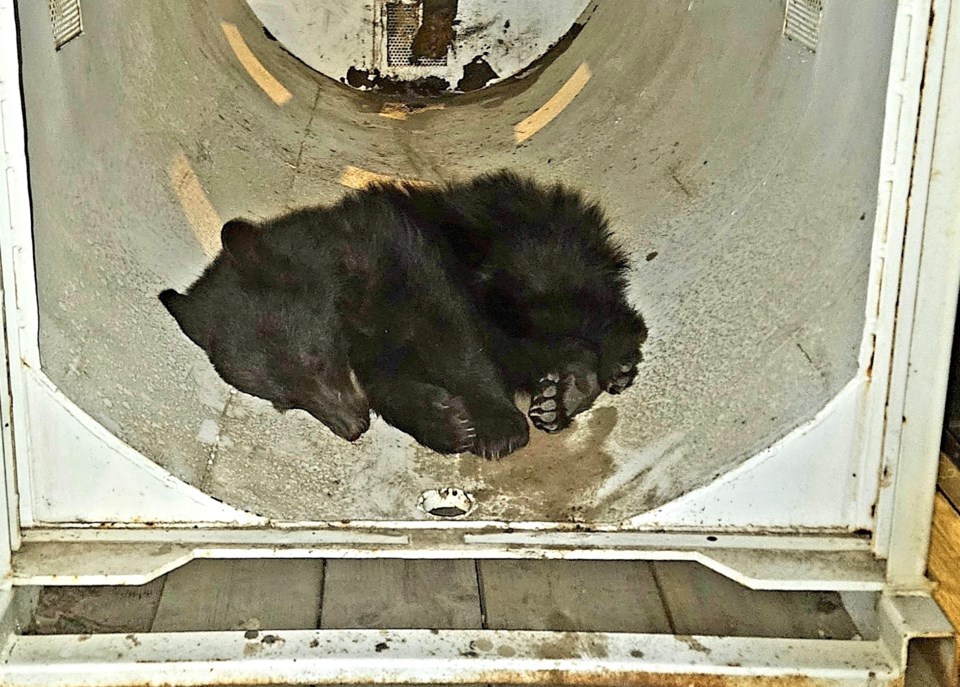A young black bear cub captured in the Town of Westlock Halloween night is now on the mend in southern Alberta at the Alberta Institute for Wildlife Conservation (AIWC).
After spending Halloween night in the care of Fish and Wildlife officers, the male cub was taken to a wildlife specialist in Spruce Grove Nov. 1 where he spent another night, and on Nov. 2 was picked up and transported by a staff member to the rehab centre north of Calgary.
“Once the bear got to our facility, we did a very quick exam (inside the kennel that the bear was transported in),” said Katrina Terrill, acting executive director at the Alberta Institute for Wildlife Conservation.
“We weighed the bear and we actually found that, (although) he looked very big, he only weighed 28 pounds … that’s very, very small even for a cub of this year. Normally, we would want to see them around at least 60 pounds before they would go into hibernation,” she said, noting the intake process for bear cubs that come into their facility.
“Fish and Wildlife who does the capture of all orphaned bear cubs in Alberta, they’ll evaluate whether that bear is potentially suitable for rehabilitation and release,” said Terrill. “Once they’ve done that process they contact us.”
She said the bear was probably wondering around town because with no mom in sight, it did not have enough fat reserves on its body and was in fact “too thin to go into hibernation.”
They usually conduct a full exam with their veterinarian when a bear comes to their centre, but with the poor condition this bear cub was in, they decided to wait and had no further medical information available.
He is now on a re-feeding protocol to slowly bring up his weight before they conduct the full exam.
“When an animal comes in that’s really, really skinny like this, we have to be careful not to feed them too much, otherwise they can go into shock,” she said. “He’s on very minimal rations at the moment and we’re slowly going to be increasing the amount of food he gets every day. We just want him to put on a little more weight before we can do that full check-up on him.”
Terrill said the bear is now settled in his new home and was “in better condition” than they anticipated when he first came to the facility.
“He’s been put in our outdoor bear enclosure and he was running around and climbing some of the trees that we’ve got in there,” she said. “So he’s up and awake and he’s drinking out of a bowl, which is great. We haven’t actually had to give him any IV fluids which is what we want to see.”
She noted the interaction between the bear cub and the assigned workers will be very minimal.
“We only actually ever have two staff members who would go in for cleaning and feeding and we don’t go in physically with the bear,” she said, noting there are two sides to the bear enclosure and one side’s blocked off when staff go in to clean and place fresh food and water, while the bear is on the other side.
Less than 24 hours after arriving, the bear cub was still stressed and is under observation, noted Terrill, and they are being cautious about his prognosis because they haven’t completed a full exam but she added “he is doing better than expected.”
The cub is getting very minimal solid foods for the next little while, starting with a “protein heavy introductory diet” that includes eggs and will work up to fish and meat.
“If they get too much sugars, some carbohydrates and things, that is what can trigger the shock,” said Terrill.
Once he’s doing better they will introduce as “much natural food sources as possible” including berries, apples, and squash in addition to the protein.
“We’re just going to take it day by day. Ideally what will happen is he will recover through the winter, he will continue to gain weight with us,” she said. “It’s unlikely he’d go into full hibernation but he’ll probably sleep for a couple of days and then get up and eat something and then go back in to his little den that we’ve got set up.”
The outdoor enclosure and den is made of natural materials as much as possible she said, with branches and straw to keep the bear cub warm over the winter.
Typically, they see three to five bears every year at their facility she noted, adding the bear cub from Westlock is the only bear cub at the moment, but is the fourth bear cub they have rehabilitated this year, as three very young bear cubs were brought to the centre in March and were successfully released back into the wild recently. Most bears are born in February and don’t venture out of the den until May, she said.
The bear cub will winter at the rehab centre and will be released after the spring bear hunt at the end of June 2024.
“He’s in the best possible place and he’s getting the care that he needs,” said Terrill. “Thank you to everybody in the community who’s looking out for this bear as well, we do appreciate people helping out their local wildlife … the fact that he got in means that he’s got the best chance (at survival) now.”
The non-profit organization accepts monetary and food donations for its wildlife rehabilitation programs and anyone wishing to contribute to the bear cub’s care can do so by visiting www.aiwc.ca.



